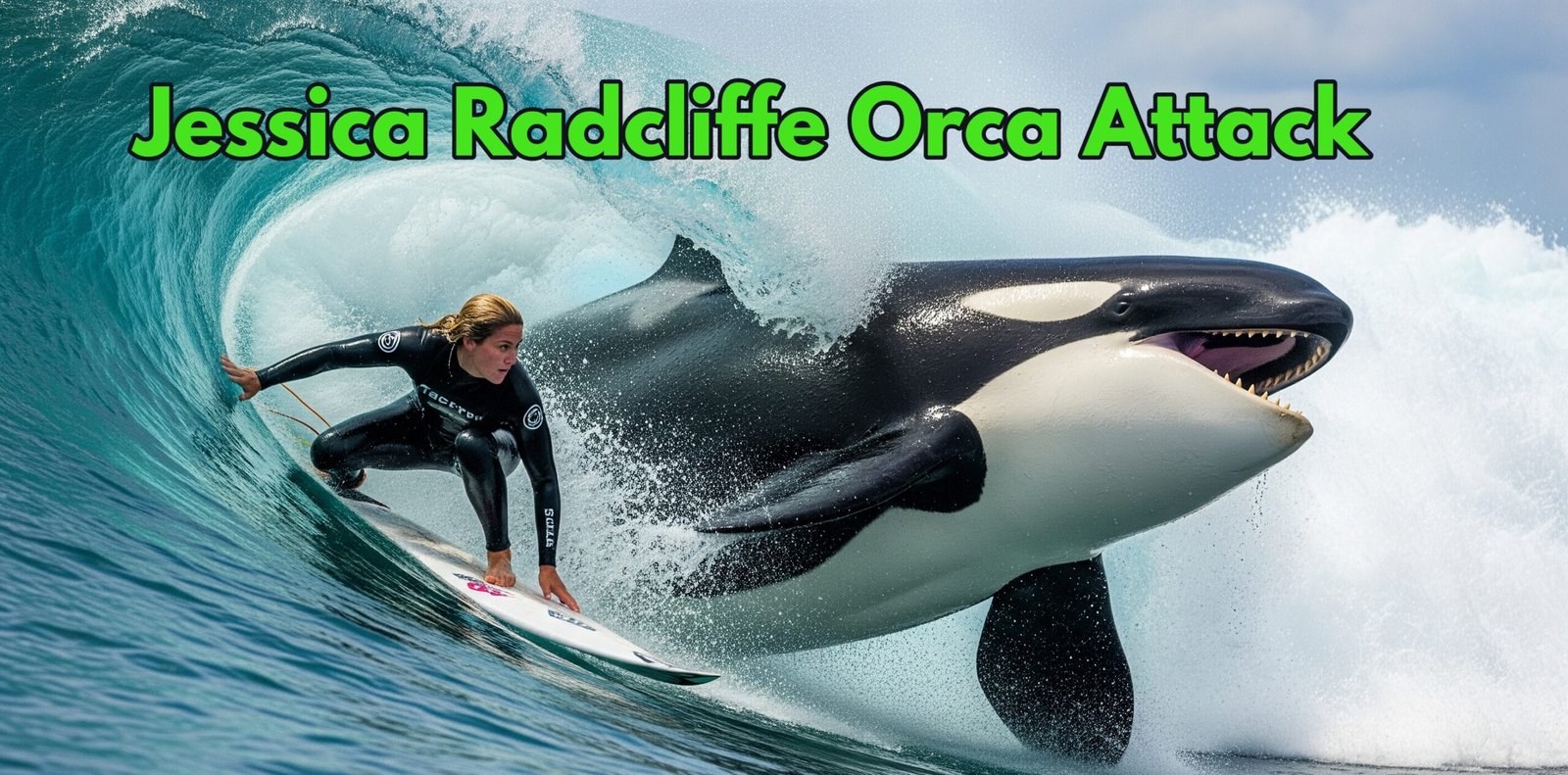Table of Contents
The Truth Behind the Tragic Jessica Radcliffe Orca Attack
Jessica Radcliffe Orca Attack : Have you seen the video? The one with the smiling marine trainer, Jessica Radcliffe, a packed audience, and a majestic orca that, in a horrifying twist, turns a spectacular show into a scene of terror. The story of the Jessica Radcliffe orca attack has swept across social media, leaving a wake of shock and debate. But what if I told you the most shocking part of this story isn’t the attack itself? It’s the fact that it never happened.
That’s right. The entire event is a fabrication, a digital ghost story that has fooled millions. But the questions it raises are very real. Why did this story feel so believable? And what are the real dangers that lurk beneath the surface when humans and killer whales interact? Let’s dive deep into the mystery of Jessica Radcliffe and separate the chilling fiction from the even more chilling facts.
Deconstructing the Viral Hoax: The Story That Wasn’t
The narrative that spread like wildfire is a modern-day urban legend. A young, vibrant trainer named Jessica Radcliffe is performing with an orca at a place called “Pacific Blue Marine Park.” The performance goes horribly wrong, and the trainer is brutally attacked and killed. The story is often accompanied by a grainy, dramatic video clip.
Why Did the Jessica Radcliffe Story Go Viral?
This story had all the elements of a viral sensation. It was shocking, tragic, and tapped into a pre-existing public debate about the ethics of keeping orcas in captivity. However, a closer look reveals the entire narrative is built on a foundation of digital sand.
- No Official Records: There is no record of a marine trainer named Jessica Radcliffe. No employment history, no news reports from credible sources, no obituary, and no official statement from any marine park.
- The Phantom Park: “Pacific Blue Marine Park” does not exist. It’s a fictional setting created for this fabricated story.
- AI-Generated Content: Digital forensic experts have pointed out numerous red flags in the viral videos. The audio often has the flat, emotionless quality of AI-generated voices. Visual analysis of the footage shows inconsistencies in water splashes and human movements that are hallmarks of computer-generated imagery (CGI).
This elaborate hoax plays on our deepest fears and our fascination with these powerful ocean predators. It’s a stark reminder of how easily misinformation can be packaged and spread in the digital age.
The Real Thriller: When Orca Attacks Aren’t a Hoax
While the Jessica Radcliffe orca attack is fake, the danger for trainers is very real. The history of marine parks is punctuated by tragic incidents that are far more harrowing than any AI-generated video. These real-life events are what give a story like the Radcliffe hoax its veneer of plausibility.
The Case of Dawn Brancheau: A Tragedy at SeaWorld
Perhaps the most infamous and heartbreaking incident is the death of Dawn Brancheau in 2010. Brancheau was a highly experienced and respected senior trainer at SeaWorld Orlando. She was not a novice; she was one of the faces of the park and had a deep, long-standing relationship with the orcas she worked with.
The attack happened during a “Dine with Shamu” show, away from the main stadium’s public eye but in front of a small audience. Tilikum, the largest bull orca in captivity, grabbed her by her ponytail and pulled her into the water. What followed was a brutal and prolonged attack. Tilikum didn’t just drown her; he scalped her and dismembered her arm. The attack was so violent that it took staff over 30 minutes to recover her body from the whale.
This event was not a “play session gone wrong,” as some initially tried to claim. It was a violent attack by a powerful predator. The incident became the centerpiece of the 2013 documentary Blackfish, which critically examined the psychological trauma of orcas in captivity and led to a massive public outcry and significant changes in how marine parks operate.
Other Documented Orca Incidents
The tragedy of Dawn Brancheau is not an isolated one. The history of keeping orcas for entertainment is filled with moments of aggression and violence.
- Alexis Martínez (2009): Just two months before Dawn Brancheau’s death, a trainer named Alexis Martínez was killed at Loro Parque in Spain. He was rammed in the chest by an orca named Keto, who was on loan from SeaWorld. The force of the blow was immense, and Martínez died from his injuries.
- Keltie Byrne (1991): A young marine biology student and part-time trainer at the now-defunct Sealand of the Pacific in Canada slipped and fell into the orca pool. She was pulled under the water by three orcas, one of whom was Tilikum, years before he was moved to SeaWorld. The other trainers were helpless as they watched the orcas prevent her from surfacing.
These are just a few of the documented cases. There have been dozens of other non-fatal attacks and close calls, where trainers were bitten, held underwater, or rammed by the powerful animals they worked with. These real events underscore the inherent unpredictability and danger of keeping apex predators in confined, artificial environments.
The Psychology of Captivity: Why Do Orcas Attack?
Orcas, or killer whales, are incredibly intelligent and social creatures. In the wild, they live in complex family pods and can travel up to 100 miles a day. There are almost no recorded instances of a wild orca attacking a human. So why does this behavior happen in captivity?
Experts believe the stress of confinement is a major contributing factor. The small tanks, the forced social groupings with unrelated orcas, and the daily grind of performing tricks can lead to psychological distress and aggression. This is often referred to as “zoochosis,” a form of psychosis that can develop in captive animals. The story of Jessica Radcliffe may be fake, but the suffering of captive animals is a very real issue that continues to be debated.
Frequently Asked Questions (FAQ)
Here are some quick answers to common questions about the Jessica Radcliffe story and orca attacks.
1. Was Jessica Radcliffe a real person? No. There are no official records, news reports, or obituaries for a marine trainer named Jessica Radcliffe. She appears to be a completely fabricated person created for the viral story.
2. Is the video of the Jessica Radcliffe orca attack real? No. The videos circulating online have been identified by experts as being AI-generated or manipulated. The park mentioned, “Pacific Blue Marine Park,” is also fictional.
3. Have orcas ever actually killed their trainers? Yes, tragically. There have been several documented fatal attacks on trainers by captive orcas. The most well-known cases are the deaths of Dawn Brancheau at SeaWorld in 2010, Alexis Martínez at Loro Parque in 2009, and Keltie Byrne at Sealand of the Pacific in 1991.
4. Are orcas dangerous to humans in the wild? Attacks by orcas on humans in the wild are exceedingly rare. Despite their “killer whale” nickname, they are not considered a threat to humans in their natural habitat. The aggression seen in captivity is widely believed to be a result of the stress and unnatural conditions of their confinement.
The story of the Jessica Radcliffe orca attack serves as a powerful lesson in media literacy and the enduring, tragic reality of keeping these magnificent animals in captivity. It’s a reminder to always question what you see online and to seek out the real stories, which are often more complex and heartbreaking than any fiction.
Managing multiple documents for your research on topics like this? It can be tough to keep track of all your articles, notes, and sources. If you need to combine your findings into a single, organized file, check out the simple and powerful tools at The Strategic Post. It makes consolidating your information effortless, so you can focus on what truly matters.







